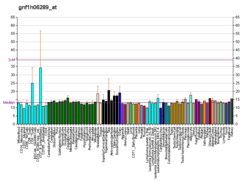AMY-1-associating protein expressed in testis 1 is a protein that in humans is encoded by the MAATS1 (formerly known as C3orf15) gene.[5][6][7]
References
- 1 2 3 GRCh38: Ensembl release 89: ENSG00000183833 - Ensembl, May 2017
- 1 2 3 GRCm38: Ensembl release 89: ENSMUSG00000022805 - Ensembl, May 2017
- ↑ "Human PubMed Reference:".
- ↑ "Mouse PubMed Reference:".
- 1 2 3 Yukitake H, Furusawa M, Taira T, Iguchi-Ariga SM, Ariga H (Nov 2002). "AAT-1, a novel testis-specific AMY-1-binding protein, forms a quaternary complex with AMY-1, A-kinase anchor protein 84, and a regulatory subunit of cAMP-dependent protein kinase and is phosphorylated by its kinase". J Biol Chem. 277 (47): 45480–92. doi:10.1074/jbc.M206201200. PMID 12223483.
- ↑ Hayes VM, Gardiner-Garden M (Oct 2003). "Are polymorphic markers within the alpha-1-antitrypsin gene associated with risk of human immunodeficiency virus disease?". J Infect Dis. 188 (8): 1205–8. doi:10.1086/378641. PMID 14551891.
- ↑ "Entrez Gene: C3orf15 chromosome 3 open reading frame 15".
Further reading
- Matsuda E, Ishizaki R, Taira T, et al. (2005). "Structure and characterization of AAT-1 isoforms". Biol. Pharm. Bull. 28 (5): 898–901. doi:10.1248/bpb.28.898. PMID 15863901.
- Ota T, Suzuki Y, Nishikawa T, et al. (2004). "Complete sequencing and characterization of 21,243 full-length human cDNAs". Nat. Genet. 36 (1): 40–5. doi:10.1038/ng1285. PMID 14702039.
- Talmud PJ, Martin S, Steiner G, et al. (2004). "Progression of atherosclerosis is associated with variation in the alpha1-antitrypsin gene". Arterioscler. Thromb. Vasc. Biol. 23 (4): 644–9. doi:10.1161/01.ATV.0000065196.61663.8D. PMID 12692006.
- Strausberg RL, Feingold EA, Grouse LH, et al. (2003). "Generation and initial analysis of more than 15,000 full-length human and mouse cDNA sequences". Proc. Natl. Acad. Sci. U.S.A. 99 (26): 16899–903. doi:10.1073/pnas.242603899. PMC 139241. PMID 12477932.
- Mashiba S, Wada Y, Takeya M, et al. (2001). "In vivo complex formation of oxidized alpha(1)-antitrypsin and LDL". Arterioscler. Thromb. Vasc. Biol. 21 (11): 1801–8. doi:10.1161/hq1101.098232. PMID 11701469.
- Bonaldo MF, Lennon G, Soares MB (1997). "Normalization and subtraction: two approaches to facilitate gene discovery". Genome Res. 6 (9): 791–806. doi:10.1101/gr.6.9.791. PMID 8889548.




